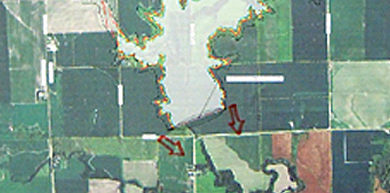Nebraska’s State Tree May Be Threatened
LINCOLN, Neb. — Early settlers and Native Americans in Nebraska used the eastern cottonwood tree for firewood, landmarks and construction materials. Even today, cottonwood is by far the most harvested and processed timber tree species in the state. But that could all change if the tree continues to decline in population, a University of Nebraska-Lincoln extension forester said.
The eastern cottonwood (Populus deltoides) has been Nebraska’s state tree since 1972. It is a native, fast-growing, relatively short-lived tree, dependent on bare soil and good soil moisture reproduce. It is most often found in riparian areas along rivers and streams, often in pure, even-aged stands.
Nebraska’s cottonwood resource is threatened because of four factors, Nebraska Forest Service/ UNL Extension forester Dennis Adams said. Flood control, land conversion, livestock grazing and herbicide damage are all causing a decrease in cottonwood population.
“Cottonwood requires bare mineral soil to regenerate,” Adams said. “It was prolific in the past due to the periodic flooding that occurred along the state’s rivers and streams.”
Historically, flooding was a common occurrence along the Republican, Platte, Blue, Elkhorn, Missouri and many other rivers and streams in Nebraska. Since the 1950s, extensive stream channelization and numerous flood control structures have affected the natural stream flow in the state’s major rivers and smaller tributaries. Occasional flooding still occurs, but not nearly as extensively as in the past, Adams said. While dams and channelization has enabled many additional uses of previously flooded riparian bottomlands, it has reduced the ability of cottonwood to regenerate.
“There’s not much we can do about cottonwood loss due to flood control because we aren’t going to take the dams out,” Adams said.
Adams said it is projected that cottonwood will continue to decrease in both area and number of trees in the future.
“Primarily a result of flood control efforts, the average size and age of our cottonwood trees have increased,” Adams said. “Recent forest inventory data indicates that our mature cottonwood stands have virtually no cottonwood regeneration, but are being encroached upon and replaced by other tree and shrub species, often undesirable species like eastern red cedar or Russian olive.”
Adams said that one way to help bring back the cottonwood population aside from planting new trees is to allow natural regeneration in riparian areas that may now be in marginal crop land.
Adams also said that farmers should be careful when using herbicides, particularly aerially applied, on adjacent crops and pastures. Herbicide drift can damage cottonwoods, causing leaves to drop or curl, slowing growth and causing dieback of branches. In extreme cases herbicide drift can kill trees.
“If farmers spray when it is too windy or too hot the herbicide can drift or volatize and can cause damage to adjacent forest land,” Adams said.
Adams said that the cottonwood provides important habitat for many small mammals and birds, including squirrels, raccoons, bald eagles and great blue herons.
“For cottonwood to continue to be a significant forest resource in the future, intervention by us may be necessary to regenerate this historic forest resource, not only for wood products, but for the important wildlife habitat, watershed protection and other environmental benefits cottonwood forests provide,” Adams said.


